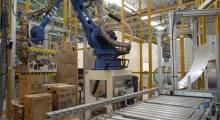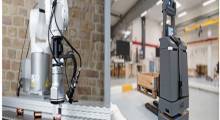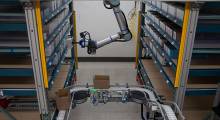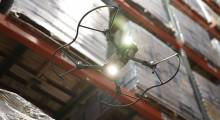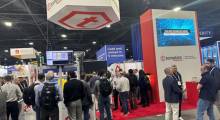Robotics hardware traditionally requires programmers to deploy it. READY Robotics wants to change that with its ForgeOS software, which it has aimed at people working in manufacturing who do not have coding skills.
The Columbus, Ohio-based startup is a spinout of robotics research from Johns Hopkins University. Kel Guerin was a Ph.D. candidate there leading this research when he partnered with Benjamin Gibbs, who was at Johns Hopkins Technology Ventures.
They obtained funding and lanched READY Robotics, now led by Gibbs as CEO.
“There was this 'a-ha' moment where we figured out that we could take these types of visual languages that are very easy to understand and use them for robotics,” stated Guerin, who is now chief innovation officer at the company.
ForgeOS supports third-party apps
READY Robotics said its “no-code” operating system is designed to enable anyone to program any type of automated device or robotics hardware. ForgeOS works with plug-ins for most major robot hardware, it said.
Like other operating systems, such Android, ForgeOS allows third-party apps and plugins, providing a robust ecosystem of partners and developers working to make robots more capable, said Guerin.
Implementing apps in robotics allows for new capabilities to be added to a robot in a few clicks, improving user experience and usability, claimed the company. Users can install their own apps, such as Task Canvas, which provides an intuitive building block programming interface similar to Scratch, a simple block-based visual language for kids developed at MIT Media Lab, which was influential in its design.
Task Canvas allows users to show the actions of the robot, as well as all the other devices in an automation cell as blocks in a flowchart. These include grippers, programmable logic controllers (PLCs), and machine tools.
The user can easily create powerful logic by tying these blocks together — without writing a single line of code, said READY Robotics. The interface offers nonprogrammers a more “drag-and-drop” experience for programming and deploying robots.
Users can work directly on the factory floor with real robots on a tablet device or with access to simulation from Isaac Sim, powered by NVIDIA Omniverse.
Design robots in simulation for real-world deployments
READY Robotics said it is making design work easier for non-programmers, helping to validate robots and systems for accelerated deployments.
The startup said it is developing Omniverse Extensions — Omniverse kit applications based on Isaac Sim — and can deploy them on the cloud. It also uses Omniverse Nucleus, the platform’s database and collaboration engine, in the cloud.
Isaac Sim is NVIDIA's application framework that enables simulation training for testing out robots in virtual production lines before deployment into the real world.
“Bigger companies are moving to a sim-first approach to automation because these systems cost a lot of money to install,” said Guerin. “They want to simulate them first to make sure it’s worth the investment.”
READY Robotics charges users license fees per software seat, and it offers support services to help roll out and develop systems.
It’s a huge opportunity, noted the company: Roughly 90% of the world’s factories haven’t yet embraced automation, which is a trillion-dollar market.
READY is a member of NVIDIA Inception, a free program that provides startups with technical training, go-to-market support, and artificial intelligence platform guidance.
Industrial automation, tool providers rely on READY Robotics
Global partners, including leading industrial automation providers, are investing in READY Robotics' software and integrating with platforms such as NVIDIA Omniverse, said Guerin.
“Right now, we are starting to work with large enterprise customers who want to automate but they can’t find the expertise to do it,” he said.
For instance, Stanley Black & Decker had difficulty deploying robotics in its factories. The global tool supplier is relying on READY to automate machines including CNC lathes and mills.
Black & Decker started using READY’s ForgeOS with its Station setup, which the companies said makes it possible to deploy robots in a day.
Create drag-and-drop robots in Task Canvas
READY Robotics said that nonprogrammers can learn its Task Canvas interface for drag-and-drop programming of industrial robots in about an hour.
The company also runs READY Academy, which offers a catalog of free training for manufacturing professionals to learn the skills to design, deploy, manage, and troubleshoot robots and automation.
“For potential customers interested in our technology, being able to try it out with a robot simulated in Omniverse before they get their hands on the real thing — that’s something we’re really excited about,” said Guerin.
Article topics
Email Sign Up




